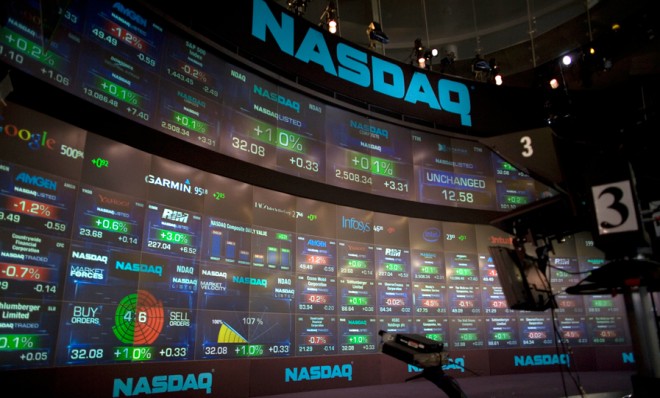Nasdaq's flash freeze and the dangers of automated trading
Regulators are stepping in to try to make markets safer

As early as next week, the Commodity Futures Trading Commission (CFTC) is expected to release a plan for regulating computer trading, which has come under intense scrutiny after yesterday's three-hour blackout on the Nasdaq stock exchange.
Computer trading has exploded in recent years to account for more than half of all stock market and future trades. It relies on complicated algorithms to analyze markets and execute enormous numbers of orders at extremely fast speeds based on market conditions.
And when even a minor glitch occurs, it can gum up hundreds of billions of dollars worth of trades.
The Week
Escape your echo chamber. Get the facts behind the news, plus analysis from multiple perspectives.

Sign up for The Week's Free Newsletters
From our morning news briefing to a weekly Good News Newsletter, get the best of The Week delivered directly to your inbox.
From our morning news briefing to a weekly Good News Newsletter, get the best of The Week delivered directly to your inbox.
Yesterday's breakdown unnerved investors and traders, and sparked concerns that the market is losing stability. Nasdaq said the problem was a "connectivity issue between an exchange participant and the SIP," or Securities Information Processor, which receives all the information for stock quotes and orders on the Nasdaq. In effect, institutional investors like hedge funds could see trades as they occurred, while retail investors could not, resulting in an unfair advantage for the former.
As a result, Nasdaq had to shut the whole thing down. Here's Floyd Norris at The New York Times:
When Nasdaq determined it was unable to distribute quotes on all stocks listed on its exchange, it asked that other markets that trade Nasdaq stocks also halt trading, and they did. As a result, no one could trade. Traders who have grown used to the idea they can get in and out of positions quickly were frustrated, and Nasdaq suffered another humiliation. Investors curious about the market reaction to specific news events had to wait. But it does not appear that any bad trades were made. [The New York Times]
The Nasdaq blackout — or flash freeze as it's being called — is just the most recent and prominent example of computer trading gone haywire. Just this week, Goldman Sachs Group sent a flood of erroneous options orders that freaked out the markets. In 2012, Knight Capital Group lost $461 million when a software glitch caused the firm to buy $7 billion in stocks in under an hour. And of course, there was 2010's "flash crash," when $862 billion in equity value vanished over the course 20 minutes before eventually recovering.
The Securities and Exchange Commission was not happy about the latest incident. Pattie Domm at CNBC:
A free daily email with the biggest news stories of the day – and the best features from TheWeek.com
Securities and Exchange Commissioner Mary Jo White weighed in Thursday evening, taking a hard tone. She said she would call a meeting exchange leaders and other market participants and would push an SEC proposal for new standards for trading and other market systems. "Today's interruption in trading, while resolved before the end of the day, was nonetheless serious and should reinforce our collective commitment to addressing technological vulnerabilities of exchanges and other market participants." [CNBC]
Meanwhile, the CFTC is preparing to release a road map that will look at a wide array of computer trading problems that could distort markets. They include the fees and incentives exchanges give to firms that execute large numbers of orders, and whether traders are using the technology to act as both buyer and seller in the same transaction, an illegal practice known as "wash trading."
But the CFTC will also look at the basic issue of how to control runaway trading algorithms that can pummel the market — a problem that may be based in the underlying software. "Both Nasdaq and the New York Stock Exchange have legacy trading systems — software that is built upon older software," says Bob Pisani at CNBC. "This software not only has to interact with older Nasdaq software, it has to interact with software from other exchanges and trading systems."
Others say regulators may have to force markets to rely more on a human touch. Marcy Gordon at The Associated Press:
High-speed trading commanded by mathematical formulas rather than people brings "the possibility of a calamity," [former CFTC official Michael] Greenberger said.
Regulators need to slow down automated trading by requiring trades to be placed "with human input," he said. [Associated Press]
And even members of Congress are getting involved. Sen. Charles Schumer (D-N.Y.) said it was time for the regulators to consider "fundamental market structure reforms."
Carmel Lobello is the business editor at TheWeek.com. Previously, she was an editor at DeathandTaxesMag.com.
-
 Film reviews: ‘Marty Supreme’ and ‘Is This Thing On?’
Film reviews: ‘Marty Supreme’ and ‘Is This Thing On?’Feature A born grifter chases his table tennis dreams and a dad turns to stand-up to fight off heartbreak
-
 Political cartoons for December 14
Political cartoons for December 14Cartoons Sunday's political cartoons include a new White House flag, Venezuela negotiations, and more
-
 Heavenly spectacle in the wilds of Canada
Heavenly spectacle in the wilds of CanadaThe Week Recommends ‘Mind-bending’ outpost for spotting animals – and the northern lights